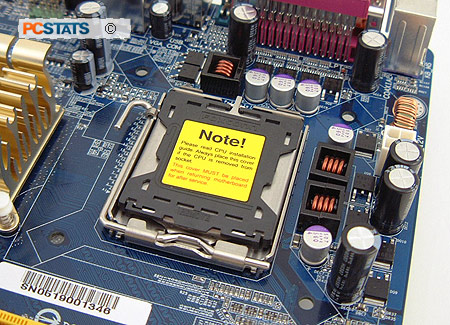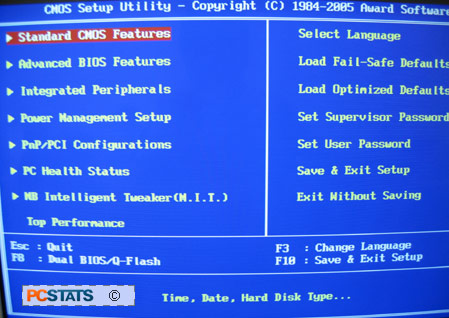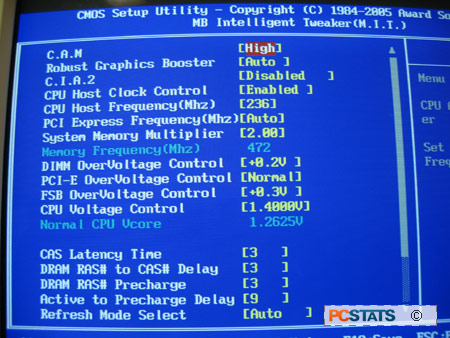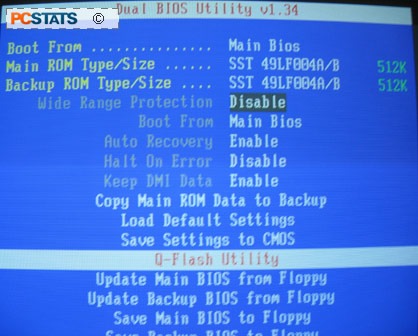 |
| Overclocking Results: |
|
|
The first go
at overclocking a new chipset is always exciting, but unpredictable too. Intel's
chipsets have historically been solid overclockers, so we were interested to see
what we would get out of this more mainstream of the company's two newest
offerings. Gigabyte does not have the greatest reputation for hardware
overclocking, but their boards have been getting better at this hobby recently,
so we had some high hopes for the GA-8I945P Pro.
All the necessary options are contained within the
M.I.T. (Motherboard Intelligent Tweaker) section of the BIOS, though seeing that
the GA-8I945P Pro uses an Intel processor, CPU multiplier was not a factor.  We set the system memory to 200MHz and began raising the FSB of
the motherboard 5-10MHz at a time.
We set the system memory to 200MHz and began raising the FSB of
the motherboard 5-10MHz at a time.
The first problems occurred at 230MHz FSB, when the
system started spontaneously rebooting on startup. Increasing FSB
voltage by +0.2 and CPU voltage to 1.3V cured this, but we still
experienced instability in 3DMark 2005. ultimately, we had to
increase FSB by +0.3V and Vcore to 1.35V before we could complete our test benchmarks and
continue.
Sadly, we couldn't get much further, as no amount of
tweaking would push the Gigabyte GA-8I945P Pro past 236MHz FSB with its Intel P4
D 840 processor. The board would reset the FSB to 200MHz every time. A speed of
236MHz is not bad at all though, especially for a motherboard and processor based on brand new silicon. We'd
consider this a positive result for the GA-8I945P Pro and a good sign for the
future of the 945P chipset.
Inside the GA-8I945P Pro BIOS
The familiar blue screen of the Award BIOS here.
Like most gigabyte boards, pressing CTRL+F1 at the main BIOS screen will
enable several advanced options such as the 'Top Performance' setting
and many extra entries in the 'advanced BIOS settings'
screen.

Most of the interesting overclocking options are contained within
the M.I.T. (Motherboard Intelligent Tweaker) screen. By enabling the CPU Host Clock Control option, you
can type in your desired FSB speed from 100-600MHz. Voltage for memory,
FSB, PCI and CPU can be increased using the respective
'overvoltage' controls here too. memory can be cranked up to a maximum of +0.6V,
FSB to +0.35V and the CPU to +1.6V. As you can see,
most of the important memory settings are also on this page, making it your one
stop overclocking shop.

Interestingly, though hyperthreading is not present
on Pentium D CPUs, disabling hyperthreading (which is enabled by default)
on the GA-8I945P Pro caused Windows and CPU-Z to only see and use one core
on our processor.

Like most Gigabyte boards, the Dual-BIOS
option is present on the GA-8I945P Pro and can be accessed by pressing F8 at the BIOS
screen. Gigabyte's Q-BIOS flashing utility is also present on this menu, and is
extremely easy to use.
 |
| PCStats Test System Specs: |
| processor: |
intel
pentium 4 d 840
intel pentium 4 540
|
| clock speed: |
16 x 200
mhz = 3.2 ghz
16 x 200 mhz = 3.2
ghz |
| motherboards: |
albatron px925xe pro-r (925xe)*
gigabyte ga-8anxp-d (925x)*
msi 915p neo2 platinum (915p)*
dfi lanparty 875p-t (i875p)**
asrock 775v88 (pt880)**
ecs rs400-a (rs400)*
via pt894 ref motherboard (pt894)*
aopen i915pa-plf (915p)*
gigabyte ga-8n-sli royal (nf4-sli ie)*
gigabyte ga-8i945p pro
(945p)** |
| videocard: |
msi rx800xt-vtd256e*
asus
x800xt/vtd** |
| memory: |
2x 512mb crucial ballistix pc5300 ddr2
|
| hard drive: |
40gb western digital special ed
74gb western digital raptor sata |
| cdrom: |
aopen combo 52x |
| powersupply: |
seasonic super tornado 400w |
| software setup
|
windowsxp
via 4in1
4.55v
forceware 6.53
catalyst 5.4 |
| workstation benchmarks
|
sysmark
2004
business winstone 2004
content creation 2004
super pi
sisoft sandra
2005
pcmark04
3dmark2001se
3dmark05
aquamark3
comanche 4
x2: the
threat
ut2003
ut2004
doom 3
| |
pcstats
has upgraded its test platform with a couple of 74gb western digital WD740 Raptor hard drives, replacing the trusty 40GB WD
IDE HDDs as test drives. Please keep that in mind when viewing the office and
disk benchmarks. Also note that this board was tested with the Intel Pentium 4 D
840 CPU, while the remaining reference boards were tested with an Intel Pentium
4 540 CPU; both are clocked at 3.2GHz.
